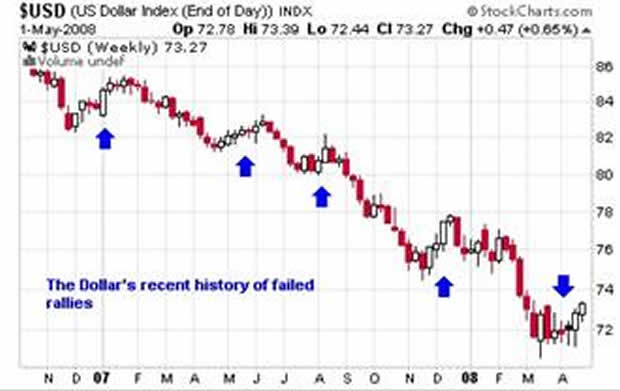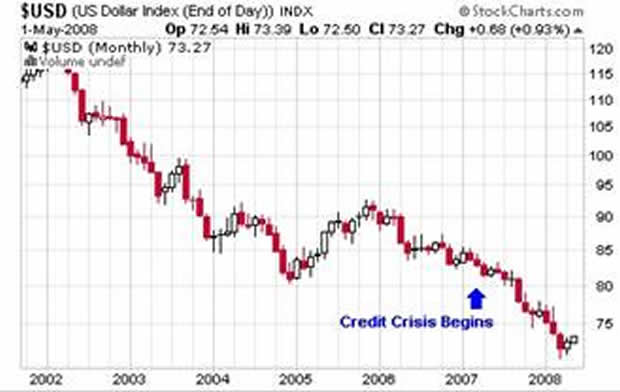Debt the Price for Economic Growth
Economics / US Economy May 02, 2008 - 05:09 PM GMTBy: Andy_Sutton

 Our call from last week is playing out exactly as we forecasted. The Fed cut interest rates, signaled a willingness to pause, and the Dollar has begun another dead cat bounce. Included below is a chart that shows other dead cat bounces that have occurred during the past year. Note the end result of each of the prior bounces: an ultimately lower Dollar. There is no reason to believe this time will be any different. We outlined the reasons for this assumption in last week's piece.
Our call from last week is playing out exactly as we forecasted. The Fed cut interest rates, signaled a willingness to pause, and the Dollar has begun another dead cat bounce. Included below is a chart that shows other dead cat bounces that have occurred during the past year. Note the end result of each of the prior bounces: an ultimately lower Dollar. There is no reason to believe this time will be any different. We outlined the reasons for this assumption in last week's piece.

Some pundits have also tried unsuccessfully to make the case that the only reason the dollar is falling is because of the credit crisis. As the following chart will show, this position is completely absurd. The Dollar Index had undergone nearly a 33% drop before the first hint of crisis emerged at the end of February 2007. Did the currency markets see the credit crisis coming almost 5 years in advance? Hardly. The seeds of the credit crisis were being planted by these same folks back in 2002 and 2003.

The ‘Cost' of Growth
Earlier this week the Commerce Department released its advance numbers for GDP growth in the first quarter or 2007. Amazingly, we are not in an ‘official' recession. Not surprising though given that this is an election year. The growth came through at .6% annualized after being discounted by a laughable 2.6% for inflation. Instead of pointing out the obvious flaws in the inflation calculation, I'd like to take this in a different direction. Let's be charitable for a minute and say that the 2.6% inflation rate is accurate and that we really did get .6% growth.
In the first three months of 2008, the Treasury Budget Deficit was $109.5 Billion Dollars. During the same three months, the trade deficit was $180.10 Billion, resulting in a Current Account deficit of a whopping $289.6 Billion. For the first quarter!! This is what a .6% growth in GDP ‘cost' future generations. This translates into $3.21 Billion each day. Our debt addiction is growing. Pundits will point out that wrapped into this equation is a one-off event in the form of the $168 Billion tax stimulus. I would respond with the fact that not included in this number is much of the war spending, and even more importantly, the ever-increasing net present value of America 's unfunded liabilities.
Put another way, it cost the United States $289.6 Billion to get ‘growth' of $111 Billion. That translates into spending $2.60 for every $1 of GDP growth. When you consider the big-ticket items that AREN'T included in the Federal budget deficit, the situation is only exacerbated.
Putting it very simply, even the cooked books don't look good. In fact they look downright awful.
Irresponsible Central Banking
Against this backdrop the Fed made the conscious decision to continue to cut interest rates to help out the financial sector at the expense of average Americans. The Fed continues to be in a tight spot but, thanks in large part to the helpful media, is able to get a free pass with regards to many of the obvious questions that need asking right now. This media simply will not ask them. They will not ask why we need to borrow over $2 to get a dollar's worth of growth.
They will not challenge the obvious chicanery that goes on each month with regards to the CPI, GDP deflator and other inflation metrics. They will not ask why the average American family needs two incomes plus debt to maintain a standard of living similar to what one income alone provided the 1960's. They will not ask why when corporate executives cook their company's books, jail sentences are occasionally meted out, yet when Uncle Sam does the same thing it passes for smart fiscal policy.
As a nation, we are hanging our collective hat on the notion that foreigners will continue to recycle trade deficit dollars through our economy by buying US Treasuries. That is essentially the only thing that stands between the United States and a rapid, Weimar-type hyperinflation right now. Regrettably, at this point the question is not if we will see a hyperinflation, but when. The worm turned on March 15 th when the Fed finally asserted itself as the fixer of all financial system woes and the lender of last resort.
Unfortunately, the nasty little secret is that there is one more place for them to pass the buck: the American consumer.
We will discuss this situation in greater detail on our weekly Internet radio program ‘Beat the Street'. The show starts at 8:30 PM EDT on Sunday evenings. For more information or to listen, please visit www.blogtalkradio.com/my2cents
By Andy Sutton
http://www.my2centsonline.com
Andy Sutton holds a MBA with Honors in Economics from Moravian College and is a member of Omicron Delta Epsilon International Honor Society in Economics. His firm, Sutton & Associates, LLC currently provides financial planning services to a growing book of clients using a conservative approach aimed at accumulating high quality, income producing assets while providing protection against a falling dollar. For more information visit www.suttonfinance.net
Andy Sutton Archive |
© 2005-2022 http://www.MarketOracle.co.uk - The Market Oracle is a FREE Daily Financial Markets Analysis & Forecasting online publication.


